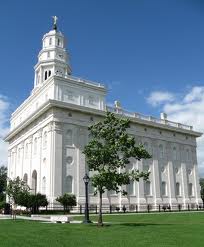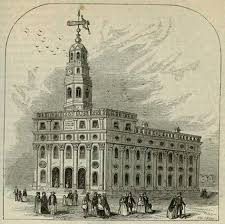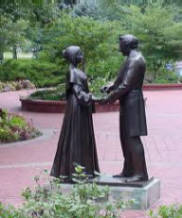


Missouri and Nauvoo Trip - Kerby Family 2014

The Setting in Western New York
Joseph Smith, Sr., chose to settle in Palmyra, a small village in the Finger Lakes area of New York state. The region bore this name because the lakes resembled fingers. Sparsely inhabited at the turn of the nineteenth century, the population of the Finger Lakes area grew rapidly. By 1820 there were many communities along the shores.
Fertile soil and heavily wooded land contributed greatly to the territory’s growth. The Erie Canal, a vital inland waterway designed to transport goods and persons across New York State from Albany to the Great Lakes, also brought growth to the area. Completed mostly by hand in 1825 at a cost of more than seven million dollars, this 363-mile watercourse reduced transportation time across the state from three weeks to six days and cut expenses by millions of dollars. The canal passed within a block of Palmyra’s main street.
Joseph Smith, Sr., the father of a family of ten—eleven by 1821—worked hard for a living. After two years in Palmyra, he accumulated enough money for a down payment on one hundred acres of wooded land in the nearby township of Farmington. During the first year he and his sons cleared thirty acres of heavy timber, prepared the ground for cultivation, and planted wheat. 2 Clearing land meant not only felling trees with handsaws and axes but also removing stumps and roots by sheer physical toil of man and beast. Young Joseph later recalled that “it required the exertions of all that were able to render any assistance for the support of the Family.” 3 Eventually the township of Farmington was divided, and in 1822 the Smith farm became part of the newly created township of Manchester.
At this time Joseph’s opportunities for schooling were limited. He attributed this to the “indigent circumstances” he was raised under. “We were deprived of the benefit of an education. Suffice it to say, I was merely instructed in reading, writing, and the ground rules of arithmetic which constituted my whole literary acquirements.” 4
As more and more Americans crossed the Catskill and Adirondack mountains to settle in the Finger Lakes area of western New York, they tended to lose contact with established churches in their former homes. These “unchurched” settlers worried religious leaders of the main denominations, principally the Baptists, Methodists, and Presbyterians, who established proselyting programs for their disadvantaged brothers in the West.
The Methodists and Baptists were particularly zealous in their efforts to bring religion to those without its benefits. The Methodists employed circuit riders. These were traveling ministers who rode horseback from town to town throughout a given region, or circuit, ministering to the religious needs of the people. The Baptists used the farmer-preacher system. In this system a local man earned his living by farming but occupied a nearby pulpit on the Sabbath.
These efforts were bolstered by the enthusiasm of the Second Great Awakening which was then sweeping the United States. Nearly all churches in upstate New York conducted revivals. These were evangelistic gatherings designed to awaken the religiously inert. Revivals were often in the form of camp meetings held on the edge of a grove of trees or in a small clearing in the forest. Participants often traveled many miles over dusty or rut-filled roads to pitch their tents or park their wagons on the outskirts of the encampment. Camp meetings frequently lasted several days with some sessions lasting nearly all day and into the night. Ministers rotated, but it was not uncommon to find two or three ministers exhorting their listeners simultaneously. 5 So fervent and enthusiastic was the religious zeal in western New York in the early 1800s that the region came to be known as the Burned-Over District. Because the Finger Lakes area was set figuratively ablaze with evangelistic fire, it is not surprising that young Joseph Smith and his family were caught up in the fervor.